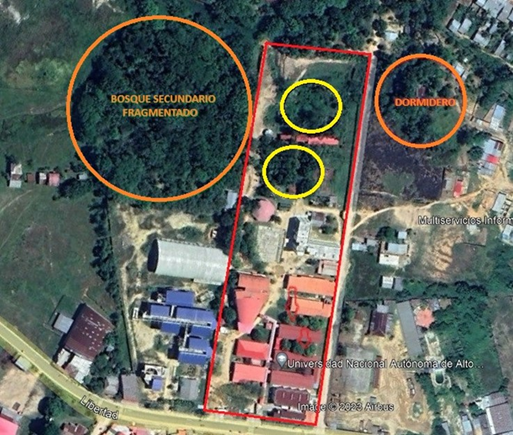Birds on the campus of the Universidad Nacional Autónoma de Alto Amazonas (Yurimaguas, Loreto, Perú)
DOI:
https://doi.org/10.56926/repia.v2i2.42Keywords:
avifauna, biodiversity, birdwatching, Peruvian AmazonAbstract
The Peruvian Amazon boasts a vast diversity of birds. In Loreto alone, there are approximately 1040 species, with some of them categorized as threatened. This research was conducted between May and June 2023 with the aim of sighting, recording, and identifying the diversity of bird species present on the campus of the Universidad Nacional Autónoma de Alto Amazonas and its surroundings. Direct observation, auditory methods, and playback were employed using equipment such as binoculars, a digital camera, and a speaker for birdwatching. A total of 58 bird species were identified, grouped into 14 orders and 28 families. The Passeriformes order was the most abundant, followed by the Psittaciformes. The presence of a parrot roost near the campus and four species of interest for birdwatching tourism and nature photography, Passer domesticus (an introduced species), Thlypopsis sordida, Galbalcyrhynchus leucotis, and Chlorestes cyanus were documented. It is concluded that a comprehensive study is needed to identify the species inhabiting the city of Yurimaguas and its surroundings.
Downloads
References
Bates, H. W. (1863). The naturalist on the River Amazons, A record of adventures, habits of animals, sketches of Brazilian and Indian life and aspects of nature under the Equator during eleven years of travel. In J. Murray. J. Murray. https://doi.org/10.5962/bhl.title.21335
Castillo Palacios, L., Castañeda Córdova, L., & Quinteros Carlos, Z. (2014). Aves del campus de la Universidad Nacional Agraria La Molina (Lima-Perú) - Una revisión de su abundancia, distribución y diversidad desde 1992 al 2010. Ecología Aplicada, 13(1–2), 117. https://doi.org/10.21704/rea.v13i1-2.462
IUCN. (2020). The IUCN red list of threatened species.
Johnson, R. R., Brown, B. T., Haight, L. T., And, ~, & Simpson~, J. M. (1981). Playback recordings as a special avian censusing technique. Studies in Avian Biology, 6, 68–75.
Madrid Ibarra, F. de M., & Cruzado, C. E. (2017). Avistamiento de aves en el campus de la Universidad Ricardo Palma, Lima, Perú. Biotempo, 14(2), 167–177. https://doi.org/10.31381/BIOTEMPO.V14I2.1667
Martin, L. B., & Fitzgerald, L. (2005). A taste for novelty in invading house sparrows, Passer domesticus. Behavioral Ecology, 16(4), 702–707. https://doi.org/10.1093/BEHECO/ARI044
Raimondi, A. (1862). Apuntes sobre la provincia litoral de Loreto. Tipografía nacional, por MD Cortés.
Rufino, M. P. M. X., Torres, C. M. M. E., de Melo, F. R., de Figueiredo, L. T. M., da Rocha, S. J. S. S., Schettini, B. L. S., Villanova, P. H., de Freitas, M. F., Zanuncio, J. C., Kerkoff, L. A., Ribeiro, F. C., Verly, O. M., & da Silva Costa, W. (2023). Floristic composition and dispersal syndrome: How can environmental factors affect the Cracidae refuge in a secondary Atlantic Forest fragment? Trees, Forests and People, 11, 100374. https://doi.org/10.1016/J.TFP.2023.100374
Salinas, L., Arana, A., Arana, C., Salinas, L., Arana, A., & Arana, C. (2021). Las aves del departamento de Loreto, Perú. Revista Peruana de Biología, 28(Especial). https://doi.org/10.15381/RPB.V28IESPECIAL.21915
Samamé Saavedra, J. A. (2023). Modelo de manejo para la comercialización legal y sostenible de la vida silvestre en el departamento de Lambayeque. Universidad Nacional Pedro Ruiz Gallo.
Schulenberg, T. S., Stotz, D. F., Lane, D. F., O’Neill, J. P., & Parker III, T. A. (2010). Aves de Perú. Centro de Ornitología y Biodiversidad (CORBIDI), 1, 1–660.
SENAMHI. (2023). Datos Hidrometeorológicos a nivel nacional. Servicio Nacional de Meteorología e Hidrología Del Perú. Datos Hidrometeorológicos a nivel nacional
Silva Guzmán, J. D., Pollack Velasquez, L., & Bazán Alcántara, G. L. (2012). Avifauna en el campus de la Universidad Nacional de Trujillo – Perú, Mayo – Agosto 2009. UCV-Scientia, 4(2), 197–204. https://revistas.ucv.edu.pe/index.php/ucv-scientia/article/view/962
Simamora, T. I., Purbowo, S. D., & Laumonier, Y. (2021). Looking for indicator bird species in the context of forest fragmentation and isolation in West Kalimantan, Indonesia. Global Ecology and Conservation, 27, e01610. https://doi.org/10.1016/J.GECCO.2021.E01610
Spix, J. B. von. (1840). Avium species novae quas in itinere per Brasiliam annis MDCCCXVII-MDCCCXX jussu et auspiciis Maximiliani Josephi I. Bavariae Regis. Typis. Franc. Seraph. Hubschmann. https://doi.org/10.5962/bhl.title.101634
Taczanowski, W. (1884). Ornithologie du Pérou, par Ladislas Taczanowski (Vol. 1). Typographie Oberthur. https://doi.org/10.5962/bhl.title.14183
Takano Goshima, F., & Castro Izaguirre, N. (2007). Avifauna en el campus de la Universidad Nacional Agraria la Molina (UNALM), Lima - Perú. Ecología Aplicada, 6(1–2), 149. https://doi.org/10.21704/rea.v6i1-2.351
Wang, Z., Gao, S., Huang, X., Zhang, S., & Li, N. (2022). Functional importance of bird-dispersed habitat for the early recruitment of Taxus chinensis in a fragmented forest. Acta Oecologica, 114, 103819. https://doi.org/10.1016/J.ACTAO.2022.103819

Published
How to Cite
Issue
Section
License
Copyright (c) 2023 Ronald Rolando Mori-Pezo, Pedro Mendoza-Tamani, Enrique Alejandro Barbachán-Ruales

This work is licensed under a Creative Commons Attribution 4.0 International License.
Authors retain their rights:
a. The authors retain the intellectual property rights (copyright) of the published works, assigning to the journal the right of first publication.
b. Authors retain their trademark and patent rights, and also on any process or procedure described in the article.
c. Authors retain the right to share, copy, distribute, perform and publicly communicate the article published in REPIA (e.g., place it in an institutional repository or publish it in a book), with an acknowledgement of its initial publication in REPIA.
d. Authors retain the right to make a subsequent publication of their work, to use the article or any part of it (e.g., a compilation of their work, notes for conferences, theses, or for a book), provided they indicate the source of publication (authors of the work, journal, volume, number, and date).







